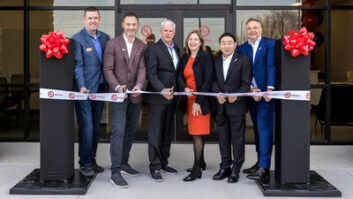Hollywood, Calif. — Retailers voiced concerns about consumer confusion and other issues revolving around HDTV during a panel at DisplaySearch’s sixth annual HDTV Conference, here, Wednesday.
Increasing confusion over newer technologies coming to market, the inability of the industry to properly communicate the HDTV experience to end users, and the increasing commodity status of big-screen flat-panel TVs that is stifling the differentiation of A/V specialists were some of the issues addressed by panelists.
Jonathan Zupnik, divisional merchandising manager for Sears Holdings, said the industry is failing to educate end users to the benefits of new technologies being introduced in HDTVs or the attachments to the HDTV experience.
“Overall, for all the things coming down the pike, if [the end users] don’t understand something, they can’t equate a value to it,” Zupnik said.
Panel moderator Stephen Baker, industry analysis VP of The NPD Group, said the impact of the economy is taking its toll on some categories, but so far the flat-panel TV segment has been relatively unscathed, citing 30 percent growth in LCD TV sales for the year, while average selling prices are holding up pretty well, he said.
“But it’s a crap shoot as to what the rest of the year is going to look like,” Baker said, pointing to recent havoc on Wall Street and in the investment banking sector.
Jeffrey Smith, Blockbuster consumer electronics category manager, said, “We have the same concerns over the economy as everyone else. Customers will buy when times are good. Customers will buy for their home when times are bad. The one thing that always makes them hold onto their wallets is uncertainty, and I think right now we are dealing with a time of uncertainty that I hope won’t start to have an impact on the business.”
Smith said Blockbuster as a content supplier “has a vested interest in the success of HDTV,” but he worries that the industry is missing an opportunity by failing to tell consumers why they need to have an HDTV.
“I am always concerned that we as an industry are confusing the customer with our messages,” Smith said. “I look at the various options that are out there for the end users — things like Video On Demand (VOD). Customers can get VOD from set-top boxes, integrated Blu-ray players, Tru2way CableCARD TVs, video game consoles, the computer and [through the computer] to some handheld devices. It’s an enormously confusing world. The obligation of the industry is to make the whole thing understandable, and we as an industry have not done a very good job of that.”
“Ultimately my concern is what is the end game here? What are we telling the customer to make their lives better?” he added. “Why do you really want an HDTV? We have lots of answers to questions that nobody’s asking. Let’s see if anybody can answer that question.”
Smith said Blockbuster launched an initiative last year to place a 40-inch HDTV display and a Blu-ray Disc player in every store to show consumers the difference between SD and HD content.
“We feel that has helped our rentals and sales of Blu-ray content quite a bit. We think it will have an even bigger impact this holiday season,” he said, adding that such practices go a longer way toward selling the HD and Blu-ray experience than discussing resolution formats and contrast ratios of HDTV displays.
Bob Gartland, president of AVAD, the high-end home theater distributor, said, “HDTV for us is something our customer adopted years and years ago. In fact, we probably only have a few 720p high-definition televisions in our mix — everything else is 1080p. So we are sort of in a different place than the general market. The biggest challenge our customers face is product differentiation and profitability as the category gets more mature. Right now our constituency represents the new specialty market, or what’s left of the specialty market. They have been very challenged over the last 24 months to be competitive in the television business to provide the kinds of service and performance levels that they do, given the business model that has played out in the TV business.
“Our challenge as a company and our customers’ challenge is to find new and different ways to continue to drive performance and be able to have a business proposition to be successful. So typically we’ve done that by selling larger and larger screen sizes and higher and higher resolution televisions. With 65-inch panels readily available today, there is not too much that can be done that is practical in the size area. Much beyond that is becoming difficult in a number of ways.
“Our dealers are running out of ways to differentiate what they do from what’s happening in the mass market, and they don’t have a business model that can sustain some of the margins that we are seeing today,” Gartland continued.
As for the fourth quarter, the panelists were generally optimistic about the prospects for TV.
Sears’ Zupnik said he is “still optimistic about consumer electronics,” adding that the “shinning spot” in the category mix continues to be televisions. As for Blu-ray Disc players, he said it will be “interesting to see what happens with pricing.”
Zupnik continued that “it is still a struggle in this economic environment to sell a lot of things other than the things consumers really need such as the television, but the idea of making a Herculean leap in your ability to attach something today in the economic environment that we have … it’s not that I’m down on the business but for me to all of a sudden do something different from what I’ve ever done before within this economy would probably be dangerous to be honest.”
Gartland of AVAD said the $64,000 question today is selling a product above the commodity level where you have to prove to the consumer why he should spend more money for it.
“I think the problem is that if you look at most retail today with all the categories and all the movement of technology, they are so challenged to do that that I don’t know what the answer is. We sell thousands of products that get integrated into someone’s home. We are trying to get vendors to work behind the scenes to get better interoperability right at the engineering level,” said Gartland. “So we have showrooms in all of our locations and in those showrooms we have systems that are completely integrated. That’s way we think we can drive a higher level of business stability at our dealers to delivery a better user experience in the home.”
Regarding the developing trend of some consumer electronics manufacturers imposing unilateral pricing practices on certain high-end goods to protect margins most of the panelists said they agreed with those steps.
Zupnik said that while his stores don’t carry most of the goods to which such policies have been applied, he said he believes most retailers generally respond well to minimum advertised pricing policies.
“But universal MAP pricing might be a stretch if it becomes very restrictive. Retailers don’t like handcuffs, and at the end of the day if you have high prices and you have to sell products, you have to do what you need to do to move that product or to get people aware of it. You are going to want to have the ability to do that,” Zupnik said.
However, he said his stores respect all of the brands it carries and it would be self-defeating to take a high-end product and sell it by “trashing the price,” especially in print advertising. He added that Sears is cognizant of brand value and has its own private-label brands with intellectual property it wants to protect.
Smith of Blockbuster said, “Regrettably retailers tend to follow each other lemming like over the gross profit cliff. You need only look at Black Friday every year to see that passion. Sadly, it’s at the point where as a retailer if you are going to make any money in the business, it is probably one of the very few ways that you can do so.
“When you use price as a differentiating factor ultimately you cannot win, because you will slip to a point where you cannot make any money,” Smith said.
Gartland said his company is in favor in unilateral pricing practices, “I think we helped to drive some of that with some of our vendors, particularly on the step-up kinds of models where dealers are investing more time and education to sell that model. Our folks really like that. They think that in a head-to-head battle they are not going to lose a sale if it’s on merit, but they do sometimes get hammered on price.”













